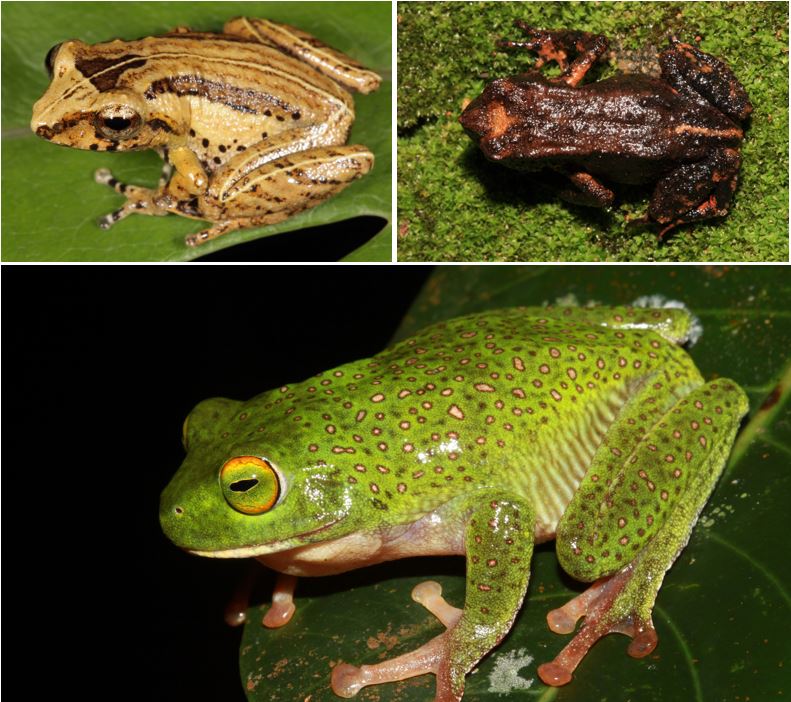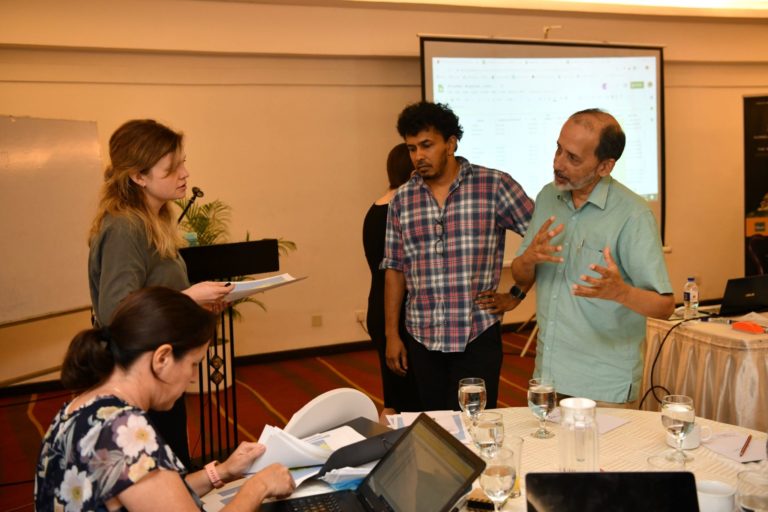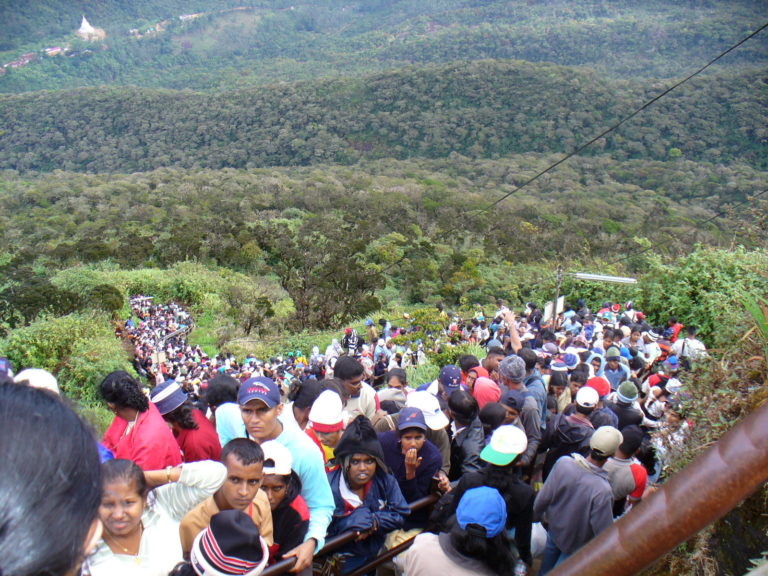- A recent global IUCN Red List assessment of the amphibians of Sri Lanka has highlighted that 72 of them are threatened with extinction, with 20 critically endangered.
- Evaluators identified the rapid loss of wet-zone cloud forests as the most immediate threat to the island’s amphibians, and highlighted three priority sites that are uniquely important for their conservation.
- In recent years, Sri Lanka has recorded the highest number of amphibian extinctions in the world and rediscovered only three of 21 amphibian species previously considered extinct, highlighting the need for more research and strategies for amphibian conservation.
- Though a small Indian Ocean island, Sri Lanka is recognized as an amphibian hotspot, with 116 species, 90% of them found nowhere else on Earth.
COLOMBO — Adam’s Peak is Sri Lanka’s fourth-highest mountain and considered a holy site for people of multiple faiths, who flock there in their thousands during the pilgrimage season from December to May each year.
The trail to the summit cuts across the biodiversity-rich Peak Wilderness Sanctuary. It was on the edge of this busy trail that herpetologist Mendis Wickramasinghe rediscovered the Kandyan dwarf toad (Adenomus kandianus), thought to be extinct for nearly 133 years.
Wickramasinghe and his team also rediscovered two more amphibians, the starry shrub frog or Kelaart’s starry shrub frog (Pseudophilautus stellatus) and the webless shrub frog (Pseudophilautus hypomelas), previously categorized as extinct, and eight species new to science from this important habitat.
“The Peak Wilderness Sanctuary is a very significant site for amphibians, but the solid waste generated as a result of the pilgrims polluting the area, specially its waterways, has a direct impact to the amphibians,” Wickramasinghe told Mongabay.
He was instrumental in pushing for the location to be identified as one of three key amphibian conservation priority areas in Sri Lanka, along with the Sinharaja Forest Reserve and the Knuckles Forest Reserve, during a recent Amphibian Red List Assessment workshop in Sri Lanka.

Local assessment after 15 years
The global IUCN Red List assessment for the amphibians of Sri Lanka brought together more than 25 scientists engaged in amphibian research. It was a chance to share their data to map the distribution and abundance of amphibians to update each species’ conservation status under the IUCN Red List.
The assessment workshop, held from Feb. 17-20, was facilitated by the IUCN’s Amphibian Red List Authority and supported by Dilmah Conservation.
The new assessment has raised red flags over the state of the country’s amphibians. “Of the 116 species currently recognized from Sri Lanka, 72 are threatened with extinction,” Madhava Meegaskumbura, the co-chair of the National Amphibian Specialist Group, told Mongabay. “Twenty of them were assessed as critically endangered; which means that unless recovery programs are designed and implemented immediately, they stand a high risk of becoming extinct.”

Sri Lanka’s first global amphibian assessment was in 2004, when its official count of amphibian species stood at 107 and the assessment showed 54 as threatened and 10 as critically endangered. The 2004 assessment also listed 21 species as extinct because they had not been recorded in more than 50 years, making Sri Lanka one of the countries experiencing a rapid decline in its amphibian population.
The number of amphibian species recorded from Sri Lanka doubled at the next count in 2005, but because work was still in an early phase, there was only limited information on the distributions of many species.
“Today, there are many scientists and conservationists working on amphibians and there is ample data on the distributions of species, populations, population trends and habitats,” Meegaskumbura said. “Also, over a dozen new species have been described during the past 15 years, and these needed to be assessed for the first time, too — so the recent Red List workshop was necessary to inform the conservation efforts of Sri Lanka’s amphibians.”

The group also identified the most immediate threat to Sri Lanka’s amphibians as coming from the rapid loss of the island’s wet-zone forests, caused by illegal encroachment. Declining rainfall, longer dry periods and rainwater acidification, especially in the central hills at elevations above 1,500 meters (4,900 feet), also pose serious threats to the island’s already vanishing amphibian populations. An indirect yet strong threat also comes from chemicals used in agriculture, which are carried into forest regions by the wind and washing into waterways from farms and plantations.

Drastic decline
The populations of several species have undergone drastic crashes in the past 15 years, the scientists concluded. For example, the Nöllert’s toad (Duttaphrynus noellerti), assessed as endangered in 2004, is now considered critically endangered. The reasons for the crash in its population are not fully understood, but it could be due to the drying of rainforest streams and natural pools, or agrochemicals used in nearby homesteads and farms, Meegaskumbura said.
Similarly, several shrub frogs such as the elegant shrub frog (Pseudophilautus decoris), Moore’s shrub frog (P. mooreorum), golden-eyed shrub frog P. ocularis and Stuart’s shrub frog (P. stuarti) have gone from endangered to critically endangered during that same period. These worrying trends suggest that there are serious problems with environmental and conservation efforts, according to the group that carried out the assessment.
While much exploration and research efforts have been carried out, there has been little in the way of conservation initiatives, whether directed at threatened species or the sites they inhabit, according to Rohan Pethiyagoda, a taxonomist and a naturalist who earlier served as deputy chair of the IUCN’s Species Survival Commission.

Pethiyagoda, whose team was responsible for describing a large number of new-to-science amphibians in 2005, played a leading role in initiating the recent assessment workshop.
“Despite its small size, Sri Lanka has about 2.5% of the world’s frog and toad species. Sri Lanka needs a scientific conservation framework if we need to conserve these threatened creatures,” Pethiyagoda said.
The assessment workshop also resulted in the revision of the number of amphibian species in Sri Lanka, with four species previously considered distinct being merged into other species. When the assessment workshop commenced, the number of known Sri Lankan amphibian species was 120; following the revisions, the figure is now 116. These revisions, however, still need to be published in peer-reviewed journals to gain global acceptance.
The final outcomes of the 2020 Red List assessment of Sri Lankan amphibians is expected to undergo rigorous technical scrutiny ahead of publication by December.
Banner image of the cheeky shrub frog, or Pseudophilautus procax, a critically endangered species inhabiting the eastern region of the Sinharaja Forest Reserve and now showing drastic population decline, courtesy of Erich Joseph.
